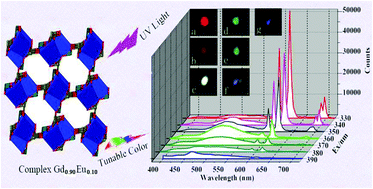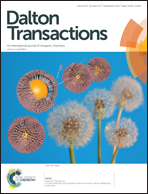Towards full-color-tunable emission of two component Eu(iii)-doped Gd(iii) coordination frameworks by the variation of excitation light†
Abstract
A series of pyrazine-2,3,5,6-tetracarboxylate alkali–lanthanide coordination frameworks, namely [NaLn(pztc)(H2O)3]·H2O [Ln = Ce (1), Sm (2), Eu (3), Gd (4) and Tb (5); H4pztc = pyrazine-2,3,5,6-tetracarboxylic acid], have been synthesized by reacting Ln(NO3)3·6H2O with H4pztc in the presence of NaOH at room temperature. X-ray crystallographic analysis reveals that complexes 1–5 are isostructural, featuring three-dimensional (3D) networks with a unique (411·68·82)(43·62·8)(43) topology in which the ligand displays a novel μ7-coordination mode. The photoluminescence (PL) spectra in the solid state reveal that complexes 2, 3 and 5 exhibit the characteristic luminescence of Sm(III), Eu(III) and Tb(III) ions, respectively, while complex 4 displays a broad band in the range of 400–650 nm (λmax = 505 nm) which exhibits about 103 nm red-shift and enhancement compared to the band of the free ligand. Further, the isostructural two-component Eu(III)-doped Gd(III) complexes realize color-tunable luminescence from red to yellow, white, green and blue by the variation of excitation wavelengths. They represent the first example of full-color-tunable emission in lanthanide coordination frameworks by the variation of excitation light.


 Please wait while we load your content...
Please wait while we load your content...